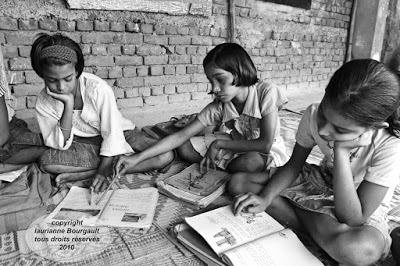
It is time we look at our education policy #GivingTuesday #India



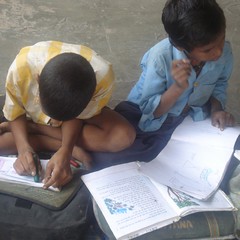
 The Right Education bill has cleared one more hurdle. A short news item on October 31st stated that the Cabinet had given its not to the Education Bill. It was about time!
The Right Education bill has cleared one more hurdle. A short news item on October 31st stated that the Cabinet had given its not to the Education Bill. It was about time!
For those who are not aware it was in 2002 that the 82nd Amendment made education a fundamental right of all children between 6 and 14. It was indeed a wow moment. The draft bill was then elaborated and debated. In July 2006 the government rejected the bill for lack of resources and the voiceless children of India were once again betrayed.
In February 2008 the Government finally accepted to take on the Bill. It was approved by the cabinet only in October.
If one peruses the twists of the tale it boils down to it is all about money honey! Everyone from the planning commission to the state governments find the financial burden to heavy to bear. never mind the millions easily spent to create new facilities to accommodate candidates from reserved categories to higher places of learning, ensuring that all the children of India go to school is not a priority. Who cares about them. The sad reality is that they are not a vote bank or a good cause to espouse. They remain voiceless and neglected. Needless to say we are referring to children of the other India, the one of the have nots. Their peers on the other side of the fence acquired their right to education long ago.
And who would you ask are the main the detractors of the Bill: surprisingly or not the private school lobby who opposes the fact that hey have to reserve 25% or more of their seats to poor students. The idea was to bridge the gap between rich and poor and ensure that all children get equal opportunities. Something many countries.
For one who has always dreamt of a common neighbourhood school, this indeed was a first step, albeit a faulty one, in the right direction. One no waits to see what happens to the Bill as its journey is still not ever. It may just get referred once again to a Committee.
The Right to education Bill has already completed five years of struggle. A long one for any Bill particularly when some get voted in no time, particularly those that can be political fodder or those that vote for raises in salaries of parliamentarians. Five years means that many children who could have benefited from it have now moved beyond the stipulated 6 to 14 years ans are now probably working in some dark corner of our land, their morrows hijacked.
True that there are many contentious issues in the Bill that need to be addressed: why 6 to 14 ? what happens to children below 6? 14 does not give you any school leaving validation? why should parents be held responsible? who will the Bill be implemented etc. But experience shows that Bills can be amended even after they are passed so perhaps one should pass it.
The children of India deserve the right to Education
But then one may softly ask: whose right is it anyway?
One of the tools used during the recent HDCA workshop was photo mapping. A cross section of pwhy children were given cameras and asked to take pictures of what they liked the most and what they disliked the most. The result was stunning and something I want to share with one and all.
The pictures below do not meet any canon of perfection. They are hazy, over or under exposed, badly centered and sometimes even out of focus but I urge you to look at them with the your heart. If you do you will be privy to the lives of children we normally never see or at best pass by: the ones that don government school uniforms and live in part of the city we never roam, children whose family left their homeland on hope of building a better future for their children, children who also have dreams and aspirations, many of which are akin to our own.
As I gleaned through them I must admit that my eyes welled many times. If you look for a common thread almost all the children took pictures of the God and Goddesses in their homes, pictures of their moms sometimes doing housework in appalling conditions, pictures of their family and siblings. Many photographed greenery, trees, plants and gardens and most took pictures of garbage and filth. There were some animals and even a banner seeking help for flood victims. A nice house, motorbikes and even a car led us towards the world of their dreams. Men at work on a road construction site or vegetable vendors were a subtle reminder they wanted to free themselves off and yet one that was their reality. nd pictures of school and library proved that they knew what education meant.
Each picture told a story, one that these children wanted us to know but did not have the words to express. I hope we have the heart to listen, see and understand.
| www.flickr.com
|
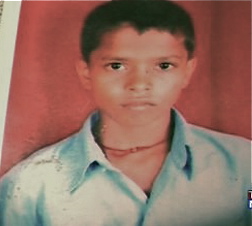
 The festival season has begun. In the next few weeks festivals of all faith will dot the calendar reminding us of the indubitable reality that we are one though some would want us to believe otherwise. Complex rituals, feasting and fasting, revelry and merriment are normally the order of the day. But as I woke up this morning I felt none of the habitual joy and excitement. What kept haunting me was the face of a little boy who lost his life in last week’s bomb blast.
The festival season has begun. In the next few weeks festivals of all faith will dot the calendar reminding us of the indubitable reality that we are one though some would want us to believe otherwise. Complex rituals, feasting and fasting, revelry and merriment are normally the order of the day. But as I woke up this morning I felt none of the habitual joy and excitement. What kept haunting me was the face of a little boy who lost his life in last week’s bomb blast.
Little Santosh was barely 10. After school like many other little boys in Delhi innumerable slums, he helped his family who ran an egg and tea stall to eek out a living. Santosh has been sent to get some more eggs as being Saturday and festival time business had been good. Like all little boys Santosh liked being sent off on errands as it allowed him to walk through the crowded markets. On that fateful day the observant lad did not miss the dropped packet and being an honest child he picked it up and tried to return it to its rightful owner. His last words were cut short by a loud bang that blew the little boy and ended his young life. A deafening why rents the air: why did this have to happen?
Another set of disturbing faces have been haunting me of late: that of young educated boys who seem to be perpetrators of the terrible acts that take innocent lives: those who drop bombs or drive away after running over another, those who whip a gun out if slightly riled, those who commit senseless acts that leave one flummoxed. . A muted and perturbing why also begs to be answered: why do young souls turn to such dastardly ways?
And above all the most disquieting why that begs us to ask who is responsible for all this and what part accrues to each one of us.
We were debating this issue yesterday with a dear friend and somehow what the powers that be, the vested interests, the seekers of answers want us to believe does not quite ring true. At best it is nothing but a half baked view of things. If there is divide in society that leads to all this carnage it is not one of faith or creed or social appurtenance. It is far more insidious and surreptitious as it is one we do not want to see and yet it is time we did have the courage to do it. The divide I refer to is the one between the have and have nots to use a jaded term, one that is growing at a vertiginous speed; one whose consequences we cannot even begin to fathom. As the rich grow richer they also seem to become more remote. Is compassion the goat to be sacrificed at the altar of what is know today as success? And as the poor grow poorer they do so while their dream and aspirations grow in quantum leaps.
The fragile and yet all important egos of the young craves for recognition. Everyone wants to be valorised, remembered, recognised, in a word to be someone. No one wants to become a faceless and nameless soul that runs the risk of sinking into oblivion. Each one wants to have an identity and sadly as things are today, no one is willing to give them one. The education doled out to them is faulty and even their most valiant efforts at studies never enables them to reach the ranks of their rich peers; success in their world is limited to a few add ons that no one sees. They may be able to achieve a little more than their parents but a heavy lead ceiling hangs over their lives and can never be broken. In other lands education enables one to rise to unknown heights and break the glass ceiling but in ours even education has bowed to the unwritten rule that governs society: schools for the rich and those for the poor. The divide becomes even more glaring as to counter the slums of the poor we have gated communities for the rich, society is getting ghettoised.
The majority bows quietly and accepts to play the game. A few do not and desperately seek that elusive recognition, that misplaced moment of so called glory. Some even go a step further and fall into the trap of lurking predators looking for the fall guy, the one who will translate their vile schemes into reality. The game is on…
Is there are a way out? One wonders. Perhaps there is but it requires moral courage and commitment. It requires many of us to give up some of the what has been acquired and perfected over the years, it requires to look deep into ourselves and not look away. The main issue is to find ways of bridging the gap that exists between rich and poor and not by handing a few hand outs that we would not miss. Real and solid bridges have to be carefully built, ones that will ensure that everyone is looked at in the same way. I am no social reformer or political activist and what I say is simply based on what I have seen and experienced over the last 10 years. The simple solution that I propose is one that I have always heralded: that of the common neighbourhood school, one that is a centre of excellence and a level playing field for every child born in this land. Education has to be given its place at the helm. One could even have and Indian Education Service like the IAS to attract the best in the land. But to succeed the common school has to be made mandatory and therein lies the problem. Will we have the courage to accept this. And yet it is only then that the lead ceiling can turn to glass.
But even education is not enough without compassion as in the words of Thich Nhat Hanh compassion is the only energy that can help us relate to the world outside. Sadly compassion has long been sacrificed to many altars and is almost an alien notion. When I launched my one rupee a day programme it was also to try and rekindle compassion in a large section of society, to try and reach out to those one usually does not think of as donors and draw them into the world of giving. It still feels intuitively right.
Little Santosh did not have to die and yet he did. He is one of many innocent lives who die because we do not have the courage to face realities, because we look at the effect and forget the cause, because we have simply forgotten to look and see with our hearts. There should not be any feasting or revelry this festive season. Maybe it is time to ponder on the true meaning of the day when good conquers evil and start asking ourselves where evil truly lies in our own reality.
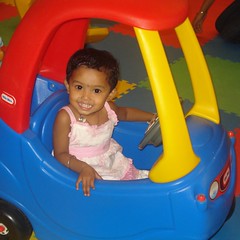
 Last week end was truly special. It was a long one – Independence day, raksha bandhan, Sunday – and was also little Komal’s second birthday. And to crown it all Utpal was at home too. So I decided to put my life on hold for these 3 days, get off the spinning wheel, shelf all worries and work and do what I almost never do: take time off and follow the kids.
Last week end was truly special. It was a long one – Independence day, raksha bandhan, Sunday – and was also little Komal’s second birthday. And to crown it all Utpal was at home too. So I decided to put my life on hold for these 3 days, get off the spinning wheel, shelf all worries and work and do what I almost never do: take time off and follow the kids.
Raksha bandhan, the festival when brothers and sisters renew their bond was touching as Kiran and Utpal are soul siblings. Utpal went to Kiran and Komal’s home and got his two precious Rakhees. Kiran was barely two when a scalded Utpal landed in our lives, and though she may have at first resented all the attention he got, she soon understood what was happening and became his little caretaker and helped look after him in every way possible. As they both grew they were inseparable and attended the same play school. She was heart broken when he left for boarding school and since has never missed a single of his PTMs and looks forward to his holidays. After the rituals it was time to go shopping. Toiletries that Utpal needed to take back to school and Komal’s birthday present. The kids knew that there would be goodies for them too, all they needed to do was look at me with their huge pleading eyes. I must say they were very reasonable!
In the evening, Utpal regaled us with his latest choreography: a 4 minute dance performance to the hit from the film Taare Zameen Par with song and sound effects. He did not miss a step or falter. It was amazing and I realised how much a child can learn through dance: coordination, rhythm and above all self confidence. I wish we could do the same at pwhy but lack of space, time and above all the reticence of parents to any form of creative pursuits are obstacles not easy to overcome.
Sunday was Komal’s birthday and it had been decided that we would take the children to the mall. Me at the mall was unheard of but had I not come off the spinning wheel of reason. WE set out early as we knew that a holiday week end meant more footfalls at malls. We also did not quite know how little Komal ,whose two little years have been spent between the cooped up space of her tiny home and the overcrowded space of the pwhy creche with a few forays into the local markets, would react. To say that she was to the manor, or should I say mall born would be an understatement. She took to the place like a fish to water. She ventured in all directions imbibing all she saw: the long brightly lit corridors, the shop and their gleaming windows. Her little face was beaming and her tiny feet busy.
We set out looking for the kid’s corner and soon found it tucked away on the second floor. It was paltry compared to the rest of the mall, as if children were not really important. And to the dismay of Kiran and Utpal, the kid zone of this mall seemed geared to toddlers and did not have much for children their age. I wonder why! We soon discovered that to be able to ride the plastic Noddy car or sit in the Barbie house you had to shell out Rs 150 per child for an hour even if the child decided to spend a few minutes. But it being treat time the appropriate amount was shelled out and the kids had their moment of fun. As we sat on the bench watching them many families passed by, some with numerous children and in spite of loud pleas and even wails, most parents were not willing to pay and just their dragged their progeny away. 150 rs per child when you have 4 children was way above many budgets. Kids play areas in malls were just like multiplexes: too expensive for the common man.
After the play area it was time for the food court and then the candy store! By the time the mall treat was over a whopping amount of money had been spent. But this was time off for the kids and their happy faces were worth every penny spent.
You can share some moments of this very special week end here:
| www.flickr.com
|
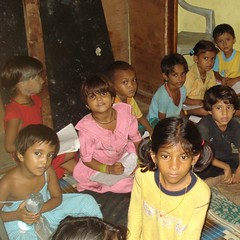
 A dear friend commented on my recent post way to go India. He wrote: I read with joy your latest blog post. 2 messages in particular struck a chord: One, how Project Why stood firm against institutional considerations and put the needs of the children as top priority. Having worked in the Education Ministry of Singapore and probably carrying on a career making education policies in future, I realized this is a dilemma most middle-tier leader face. As a young intern and observing how the current leaders go about formulating policies and making decisions, I was convinced the paramount factor is what’s best for the children – and their teachers, without whom education is impossible too, and any other administrative glitches can be ironed out. Two, the motivation and vibrancy of youth. The older I grow, the more I feel I lose this tendency to initiate things, and more importantly sustain them.
A dear friend commented on my recent post way to go India. He wrote: I read with joy your latest blog post. 2 messages in particular struck a chord: One, how Project Why stood firm against institutional considerations and put the needs of the children as top priority. Having worked in the Education Ministry of Singapore and probably carrying on a career making education policies in future, I realized this is a dilemma most middle-tier leader face. As a young intern and observing how the current leaders go about formulating policies and making decisions, I was convinced the paramount factor is what’s best for the children – and their teachers, without whom education is impossible too, and any other administrative glitches can be ironed out. Two, the motivation and vibrancy of youth. The older I grow, the more I feel I lose this tendency to initiate things, and more importantly sustain them.
I sat a long time mulling these words and their relevance particularly in a week where we celebrate 61 years of Independence and the first individual Olympic gold ever won. And instead of elation and euphoria I am filled with despondency and sadness. Is one medal in a land of a billion and counting, reason to celebrate. I cannot tell. What stares at me are the eyes of millions of potential medal winners who will never be able to do so because we have collectively failed them in every which way possible.
A tiny and unobtrusive news item must passed unnoticed by many. The Right to Education Bill was not taken up by Parliament but sent to another committee for review as vote bank politics is far more important than sending 200 million children to school. It is in 2002 that the children of India got the fundamental Right to Education. A bill was drafted in 2005 and still waits to be passed or killed! A sad state of affairs when Bills on salary raises for members of parliament are passed in a jiffy. The writing is on the wall. No one is truly concerned about the plight of the children of India and with every delay a large number of children miss their chance to be educated. It is true that the Bill threatens many bastions and social divides as one of its clause is reservation of 25% of seats in the best schools for kids from across the street and hence everyone is up in arms: how can the drivers or washer man’s kid study with mine! In all this the children are forgotten and cast aside.
The lofty idea that education would promote equality and social integration across class, caste and gender is not something we are comfortable with. True it makes great conversations pieces as well as excellent copy for campaigns and ads but when it comes too close it is simply rejected. It was way back in 1966 that the Kothari Commission had mooted the idea of a common school and though many feel that this would be an answer to education for all, it has remain a dead letter for almost half a century. The CSS (common school system) is not something we truly want.
Generations of children have been sacrificed to the alters of greed, vote bank policies, dubious lobbies are more of the same and in those lost years the divide between the rich and the poor has grown unabashedly in all walks of life, even schools who now look more like spas than places of learning. No one is truly concerned about what is best for children or should I say best for all children. The reason being that children do not have a voice and are not a vote bank! Debates will continue, it is politically correct to do so. What makes me seethe with anger is that political parties are not able to bury their differences and come together to pass such a Bill, and unless they do so no Bill that aims at inclusiveness can ever see the light of day.
In this 61st year of Independence and in the euphoria of a gold medal can one hope that things will change. I doubt it unless each one of us, particularly those who were lucky to be born on the right side of the fence, come out of our torpor and do something before we lose our ability and motivation to do so.
Will be able to do so? Only time will tell.